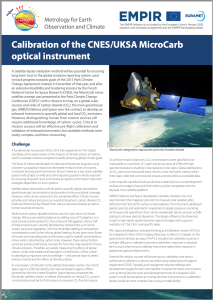MetEOC Case study: Calibration of the CNES/UKSA MicroCarb GHG monitoring satellite sensor
A primary objective of MetEOC is to facilitate the take up of the technology and measurement infrastructure developed in the project by the measurement supply chain, an example of which is recounted in the case study, hosted in a new section of this website, ‘Calibration of the CNES and UKSA MicroCarb optical instrument’.
As described, a satellite-based validation method will be essential for ensuring long-term trust in the global emission reporting system used to track progress towards the goals of the 2015 Paris Climate Change Agreement. Indeed, in December of that year, the MicroCarb micro-satellite concept was presented at the Paris Climate Change Conference (COP21) with a mission to map, on a global scale, sources and sinks of carbon dioxide (CO2), the main greenhouse gas.
The mission specifications presented significant measurements challenges for contractors for this relatively low-cost mission. Critical to mission success was pre-flight calibration and validation of the MicroCarb imaging instrument, however existing methods were costly, complex, and time-consuming.
National funding, bolstered by comparatively small but long-standing support of the MetEOC project series, supported the delivery of a solution by NPL that provided high accuracy, SI-traceable pre-flight radiometric and spectral calibrations of the MicroCarb spectrometer.
See the case study Calibration of the CNES and UKSA MicroCarb optical instrument to learn see how that was achieved…
